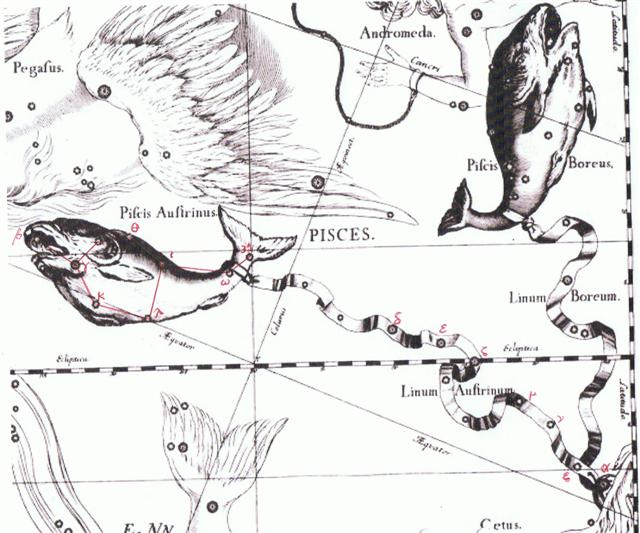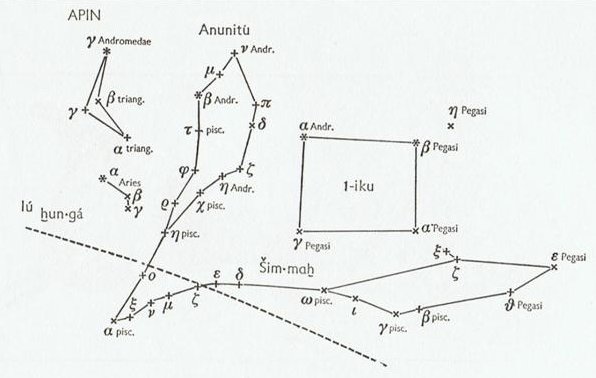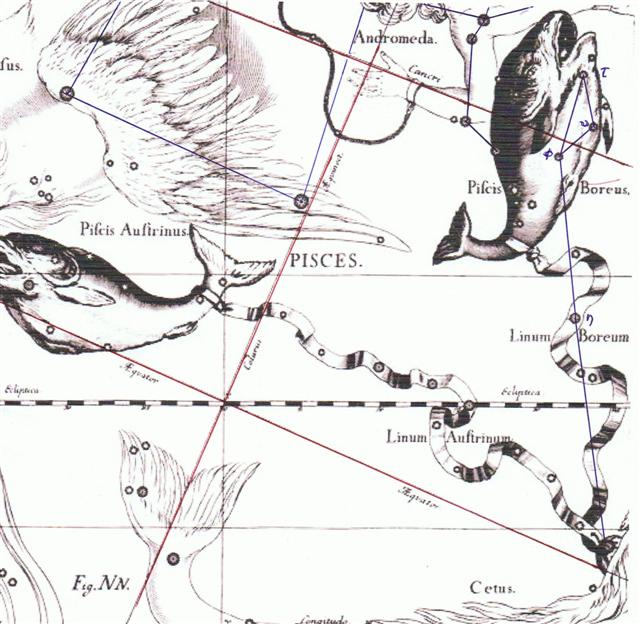On one hand there was a 'fist' rising up in front at heliacal ζ Phoenicis, at the other there was a droplet going down at nakshatra Spica.
There is a tiny dot in front both at April 5 (460) and April 6 (4-6):
Mirach - at the Belly of the Fish (Al Batn Al Hūt) - is β at the waist of Andromedae and Revati is ζ Piscium, where the ecliptic path of the Sun was crossing the band from the Southern Fish (in the west) to the knot (Alrisha, α) at the back of Cetus:
"... [Revati] ... was prominent in Hindu astronomy as marking the initial point of the celestial sphere about the year 572, when it coincided within 10' of longitude with the vernal equinox." (Allen) 1842 A.D. - 572 A.D. = 1270 and 1270 / 71 = 17.9 days. But for the Babylonians the star of significance in this place could have been τ (Anunitum), at the mouth of the current Northern Fish:
The Rainbow had the Stag on one side and the Anunitum (with a sign of Venus) on the other - 'fire' and 'water' together creating beauty. ... Then the old man was glad. He kindled a large fire, and as he wanted to keep it to himself, he built a house with a door which snapped up and down like jaws and killed everybody that wanted to get in. But the people knew that he was in possession of fire, and the stag determined to steal it for them. He took resinous wood, split it and stuck the splinters in his hair. Then he lashed two boats together, covered them with planks, danced and sang on them, and so he came to the old man's house. He sang: 'O, I go and will fetch the fire.' The old man's daughter heard him singing, and said to her father: 'O, let the stranger come into the house; he sings and dances so beautifully.' ... ... Though Andromeda has its roots most firmly in the Greek tradition, a female figure in Andromeda's place appeared in Babylonian astronomy. The stars that make up Pisces and the middle portion of modern Andromeda formed a constellation representing a fertility goddess, sometimes named as Anunitum or the Lady of the Heavens ... The glyph type vaha mea could have been inspired by Anunitum, a fish in the north standing up when Regulus culminated at midnight, because since the time of the Babylonians the mouth (door) at the Northern Fish had opened up due to the precession.
And in rongorongo times the star Anunitum had moved ahead so it would have became visible again 16 days after 0h. |
|||||||||||||||||||||||||||||||||||||||||||||||||||||||||||||||||||||||||||||||||||||||||||||||||||||||||||||||||







